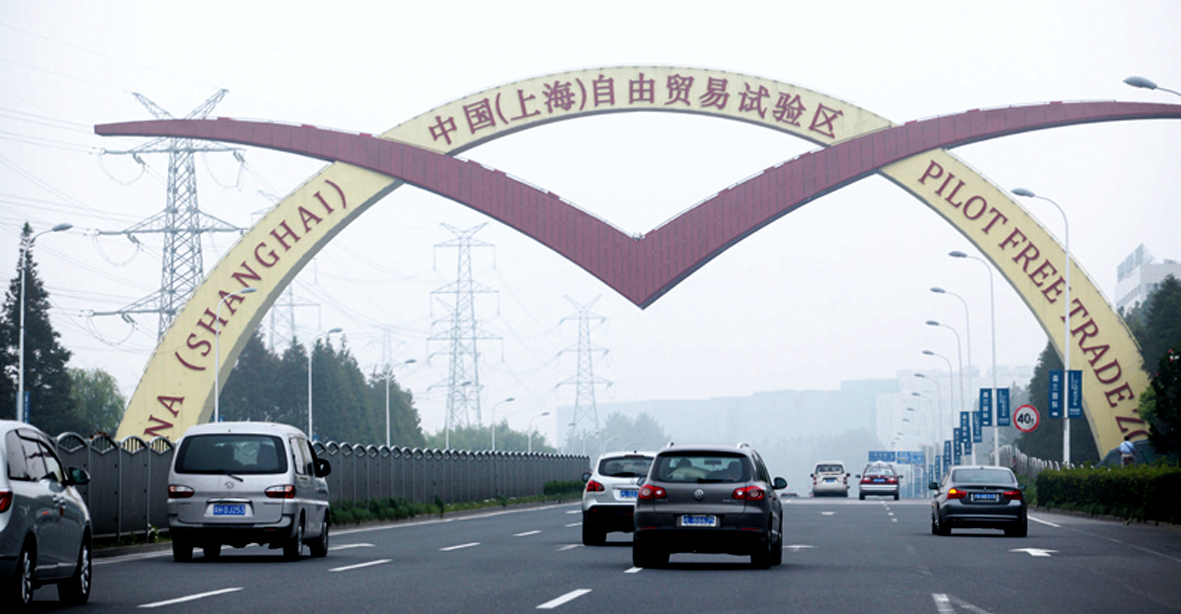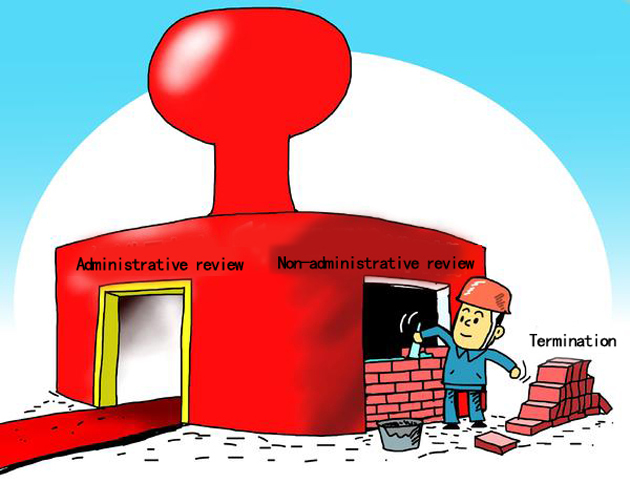Lessons learned in economic structural adjustment

The negative list, first unveiled in September 2013, is a ground-breaking document that lists the industrial sectors in which foreign investment is restricted or prohibited. Any sector not included on the list is fully open to foreign investment, and investment in sectors outside the list is no longer subject to government approval. Only a simplified “one-stop” filing procedure is required. The number of sectors was reduced from 190 to 139 in a revision in June 2014. (PHOTO: CNS)

In an effort to streamline administration, the State Council published a decision in May that would remove 48 non-administrative review items and move another 84 items into an internal review category. (PHOTO: CFP)
Since the outline of the 10th Five-Year Plan (2001-05) cited adjustment of the economic structure as a strategic goal, Chinese government has accumulated vast amounts of experience in this respect. The strategic adjustment means to optimize the economic structure with an eye toward China’s real conditions and stage of economic evolution while following the general rule of economic development.
New market-government relations
In the process of strategic adjustment, an enhanced awareness of the role of the market is accompanied by redefining government functions.
Over time, the role of the market has been redefined as being increasingly critical in the allocation of resources. Initially, it was only one mechanism among many and considered a supplement to macro-economic control. Its function was further refined as playing a “basic” and ultimately a “decisive” role. This evolution was mapped out in successive policy statements from the 14th National Congress of the CPC onward.
The Decision on Major Issues Concerning Comprehensively Deepening Reforms adopted at the Third Plenary Session of the 18th CPC Central Committee set forth the concept of “allowing the market to play a decisive role in the resource allocation and the government to play its function better.”
In the policy statement, the 18th CPC Central Committee clearly proposed that “any price that can be determined by the market must be left to the market, and the government is not to carry out improper interventions.” Prices that are determined by the government are limited to important public utilities, public welfare services and network-based natural monopolies. In other words, the government can only intervene in situations where market failure occurs, namely where market prices and competition cannot fully function.
The document set the boundary of government functions in “economic activities under the effective regulation of the market mechanism” to “reduce the central government’s administration in micro affairs to the greatest extent.” It proposed to “cancel all administrative approval procedures for economic activities under the effective regulation of the market mechanism and manage matters that require administrative approval according to procedures and with high efficiency.”
Accelerating market reform
Too much government intervention and poor oversight have hindered the healthy development and improvement of the market system. In light of this, the government intends to advance the reform of administrative approval procedures. The 2015 government work report clearly pointed out that the government “will do more to streamline administration, and delegate more powers to lower-level governments and to society in general while improving regulation.”
The first step is to further streamline administration and delegate more powers to lower levels. From 2002 to 2013, departments under the State Council cancelled the requirement of or delegated the power for review on more than 2,600 items in seven batches, accounting for 72.5 percent of the total items.
The second is to transform government functions in an innovative manner. Through cancelling, adjusting, and delegating administrative approval items, the government will gradually reduce direct administrative intervention in micro affairs. Rather, matters that can be decided by citizens, legal persons and other organizations, and that can be restrained by industrial organizations and agencies on their own would be subject to the market.
Third, the government will explore the “negative list” management model. This innovative management approach allows matters outside of the approval list to be determined by the market in accordance with the law, and it has been applied in China (Shanghai) Free Trade Zone. The “Negative list” model has replaced the pre-approval system with a filing and notification system, which shifts the focus from prior approval to ongoing supervision after the fact, emphasizing the decisive role of market mechanisms, a fair and transparent investment environment, and the reform of government functions.
Injecting private investment
Enlarging the entry of private capital is a vital step in promoting reform and adjusting economic structure.
The Several Opinions of the State Council on Encouraging and Guiding the Healthy Development of Private Investment released by the State Council in May 2010 expanded the fields and scope of private investment, encouraging and guiding the entry of private capital in the fields of primary industry and infrastructure, construction of municipal public utilities and policy-based housing, social undertakings, financial services, commerce circulation, national defense science, and high-tech industry.
Also, the 2015 government work report proposed that “local governments must completely let go of powers that should be delegated to the market or society” and “actively promote models of cooperation between government and nongovernmental capital in developing infrastructure and public utilities.”
Continuity of adjustment goals
During the 10th Five-Year Plan (2001-05), the economic structure in China mainly faced the challenges of an irrational industrial structure, a lack of coordination in regional development and a low level of urbanization. Thus, the central tasks are optimizing industrial structure and adjusting the distribution of productive forces to promote the coordinated development of regional economies and accelerate urbanization to achieve urban-rural interaction.
The 11th Five-Year Plan (2006-10) emphasized accelerating the strategic adjustment of the economic structure and stated that development should remain relatively rapid, but quality and efficiency of growth should be prioritized. According to the plan, the relationship between investment and consumption needs to be reexamined to expand domestic demand and improve technology, thus forming a rational pattern of regional development.
In 12th Five Year Plan (2012-17), strategic adjustment of the economic structure was declared the main force of accelerating the transformation of economic development pattern and a new engine of economic growth. It put forward a long-term mechanism to expand domestic demand, develop nascent strategic industries and speed up the development of the service sector to promote economic growth that is driven by the coordination among the primary, secondary and tertiary industries, stepping up regional and urban-rural structure adjustment.
The aforementioned policies have distinctive continuous and proactive features.
Quality of economic growth
The Chinese economy has now entered a “new normal.” After experiencing a phase of rapid growth, avoiding the middle-income trap appears to be a primary task of economic restructuring. In this period, the growth rate is relatively slower than it was in the initial stage of reform, signifying the first slowdown in the emerging economies as they enter a stage of transition.
After an economy of scale is created in the middle-income economies, decreasing returns to scale occurs. Accumulated contradictions caused by structural imbalances will be difficult to solve while there is dependence on outdated growth mechanisms and interest distribution in the adjustment of the economic structure.
Therefore, the thorny point in the economic structural adjustment is to locate a growth mechanism derived from the “structural imbalance” and make it workable in “coordinated structural growth.” The standard is whether it is efficiency oriented.
Examining the experience of economies that have successfully caught up with developed countries and countries that underwent smooth economic transformations, as well as the pattern of modern economic growth and structural evolution, we can see that industrialization—especially strategic export-led industrialization—is vital to catching up economically, though it is also a decisive factor contributing to structural economic imbalances.
Economic restructuring cannot avoid industrialization. The solution is to develop a new type of industrialization that relies on information technology to upgrade traditional industries.
Similarly, urbanization is the driving force of economic development as the nation tries to close the gaps with its developed counterparts, but it is an important factor leading to structural imbalances. Urbanization is not only a growth mechanism in the times of “structural imbalance” but a new path for “coordinated structural growth.” In reality, China adopts the strategy of embarking on a new urbanization road.
Yin Desheng is from the China Center for Economic Research at East China Normal University.
